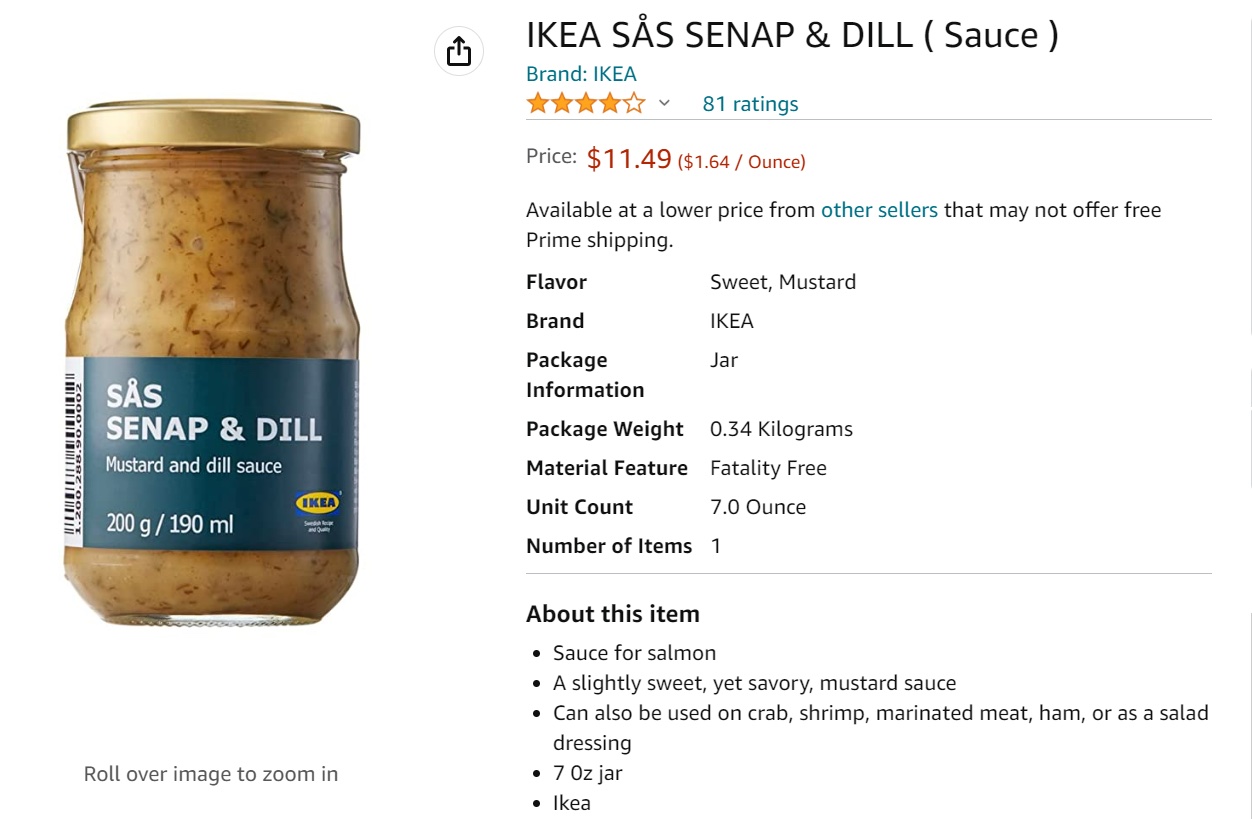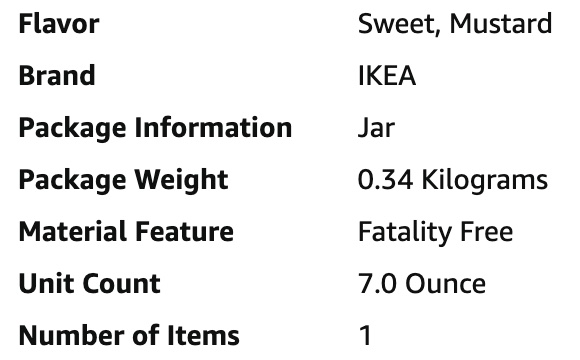Fatality-Free Dill Sauce
« previous post | next post »
Amazon screenshot from an anonymous contributor:
Remarks by the anonymous contributor:
I accidentally reached Amazon's USA website when looking for a source for this excellent dill sauce other than visiting Ikea, 35 miles from here.
How could this have arisen? Is it random, or is it something to do with the the pot being made of safety glass (if it is)? There is nothing about that in the Swedish, but the USA may require reassurance about all aspects of the product. Or was no animal harmed in making it?
I live 15.9 miles from an IKEA store and have been there many times. I never noticed anything ominous about their savory mustard and dill sauce, but I will go back soon and check it out again.
Selected readings
- "The same text but in Arabic" (8/22/20) — sign at an IKEA store
- "Ikea: Peppered Caca for the holidays" (10/27/14)
- "Speculative semiotics of Northern European product names" (4/1/08)
- "Script quiz" (2/25/07)


chris said,
April 17, 2023 @ 9:46 pm
Maybe it's vegan and the intended meaning was that no animals were killed to make it? (Although that would juxtapose oddly with the suggested uses…)
Edward said,
April 17, 2023 @ 10:34 pm
Seems to me it's likely to be "phthalate-free", with perhaps one person who did not know how to pronounce the word reading it aloud over the telephone to another person, who took a stab at what the first person might have been trying to say.
Or, of course, one or both of these 'people' could have been computers.
Björn Lindström said,
April 17, 2023 @ 10:35 pm
In Swedish this sauce is called gravlaxsås ("grave salmon sauce").
https://www.ikea.com/se/sv/p/sas-senap-dill-gravlaxsas-20028890/
martin schwartz said,
April 17, 2023 @ 11:30 pm
Hmm, on label, senap = mustard The word is traceable to Gr. sinapi, obviously borrowed. For the further etymology see WB Henning,
"A grain of mustard", charactristically interesting., erudite, and brilliant. Of course, there's nothing to the vulgar explanation of mustard as *mouse turd", I hope.
Andrew Taylor said,
April 18, 2023 @ 4:35 am
I can't even decide what "Material Feature" means. Is Material an adjective, meaning relevant, important, or a noun, referring to either the contents or the packaging?
Philip Anderson said,
April 18, 2023 @ 7:31 am
@Chris
Not exactly the same product, but the Amazon UK website has “Material feature Vegetarian” here:
https://www.amazon.co.uk/IKEA-SENAP-MILD-Mild-mustard/dp/B00RK4QW0G
@Björn
I thought the grav referred to dry curing, rather than grave in English (in either sense)? Maybe this was originally done in a hole dug in the ground?
Taylor, Philip said,
April 18, 2023 @ 10:48 am
From Amazon.Se, for a related product —
I think that we can now safely infer what "Fatality Free" means.
In the hopes of avoiding unnecessary moderation, I have removed the method from the URL and placed the remainder in maths delimiters —
https://amazon.se/Frenchs-traditionell-osthamburgare-grönsaker-kycklingsallader/dp/B00U19EYG6/
Victor Mair said,
April 18, 2023 @ 9:01 pm
Yes, problem solved, and that was my first instinct too.
jonathan silk said,
April 21, 2023 @ 3:40 am
From that source of all knowledge, Wikipedia:
The word gravlax comes from the Northern Germanic word gräva/grave ('to dig'; modern sense 'to cure (fish)') which goes back to the Proto-Germanic *grabą, *grabō ('hole in the ground; ditch, trench; grave') and the Indo-European root *ghrebh- 'to dig, to scratch, to scrape',[2][3] and lax/laks, 'salmon'.
The entry also translates as "graved salmon," which seems like it would make sense if the meaning is indeed "cure".
The entry continues:
"During the Middle Ages, gravlax was made by fishermen, who salted the salmon and lightly fermented it by burying it in the sand above the high-tide line.
Fermentation is no longer used in the production process. Instead the salmon is "buried" in a dry marinade of salt, sugar, and dill, and cured for between twelve hours and a few days. As the salmon cures, by the action of osmosis, the moisture turns the dry cure into a highly concentrated brine, which can be used in Scandinavian cooking as part of a sauce."
The origins reminded me of lutefisk, but I see now that I was confused and that that is prepared differently, and what I was evidently thinking of was instead kæstur hákarl, which Wikipedia says "begins with gutting and beheading a shark and placing it in a shallow hole dug in gravelly sand, with the cleaned cavity resting on a small mound of sand. The shark is then covered with sand and gravel, and stones are placed on top of the sand in order to press the fluids out of the body. The shark ferments in this fashion for six to twelve weeks, depending on the season. "
Well, perhaps it's an acquired taste.